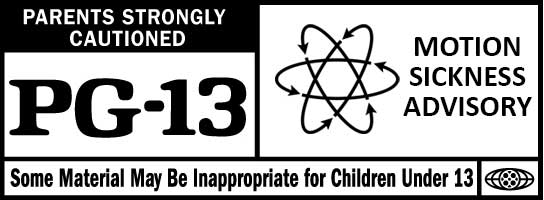Jitter Cam: A Lesson In Video Motion Sickness

Jitter Cam Blues
or
How I Wasted $10 On Motion Sickness At The Movies
Am I the only one who is getting tired of going to the movies only to spend most of my time staring at the ceiling to avoid heaving my dinner onto the theater floor?
My husband and I treated ourselves to a rare, but well-deserved night out to the movies. After checking the listings, the ratings and reviews, and after a minor squabble, we finally narrowed our choices down to two movies. For the sake of professional courtesy, I won’t mention the names of the films.
Movie number one takes place in a maximum security prison that is supposedly escape-proof. The all-star cast who designed the prison finds the tables turned on them and now they are the ones trying to get out. At least, I think that is what the movie was about …
Movie number two is based on a true story and takes place at sea on a commercial shipping vessel that is traveling through dangerous waters off the coast of Somalia. The ship is high-jacked, but the crew manages to defend the ship. However, the captain finds himself taken hostage by the hijackers and a military rescue operation ensues. At least, I think that is what the movie was about …
So which one did we see?
We decided to find out what was behind curtain number two.
Five minutes into the movie, I knew I was in for a ride to the pharmacy for the industrial size pack of Dramamine after the credits rolled.
The makers of this tense and thrilling drama, in all their infinite wisdom, decided to employ a filming technique known as “Jitter Cam.” Supposedly, it is meant to convey frenzied energy and edgy action.

Enough, already!!!
Haven’t we seen this effect too much already? Jitter cam is over-used, over-rated, and does not (in my humble opinion) result in the effect intended. Not only does this type of filming want to make me hurl my McBurger, it makes me wonder if the film crew consisted of trained professionals.
The use of jitter cam doesn’t give me a sense of frenzied activity. It gives me the sense that the camera man just came off a week-long bender. Or maybe he just chugged back twelve cases of Jolt Cola immediately prior to filming.
As I was discussing this issue with some friends, they reminded me that, of course I was going to get motion sickness; the movie takes place on the ocean.
Now, before you agree with that statement, let me first explain that I do not get seasick, and secondly, the ocean doesn’t shimmy like an alcoholic with the DT’s. The ocean swells and rolls in relaxing waves.
This movie was not the first that I have spent counting the ceiling tiles in the theater. There have been others, and I’m not the only one complaining. I understand that some movies must use hand-held camera style motion, such as when the POV involves running down the street during a riot scene, or even a little bit of jitter cam during an earthquake scene.
However, when two characters are sitting at a kitchen table discussing the impending visit of the dreaded mother-in-law, jitter cam is not only inappropriate, it makes no sense whatsoever.
So why do filmmakers insist on using this nausea-inducing technique? It does absolutely nothing for the quality of the movie. It succeeds only in driving the vertigo-challenged viewers out of the cinema and into the nearest pharmacy for gravol and pepto.
It’s enough that we have to spend so much money on a single movie ticket. Please don’t make me regret my love of the movies by turning my stomach and handing me a migraine. I don’t want to have to second-guess my decision to see a movie or wonder if I’m going to be wasting another $10.
Hollywood, please do me a favor. If you insist on using jitter cam, please put a warning label next the movie rating. That way, if I ever see a “dizzy” icon next to the PG-13, I’ll save my money and go for a ride on the spinning teacups.

